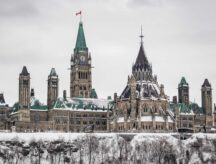Quebec needs 80,000 immigrants per year, not 50,000
Pour lire cet article en français, cliquez ici.
To sustain a strong economy, Quebec needs almost twice as many immigrants as it is currently targeting.
In recent years, Canada’s second-largest province has welcomed around 50,000 immigrants annually, ranking second behind Ontario.
On a per capita basis, however, Quebec’s newcomer intake ranked sixth among Canada’s provinces and territories.
The province’s decision last year to reduce its newcomer intake to a maximum of 41,800 in 2019 under the auspices of seeking to improve newcomer integration means that Quebec has fallen even further behind.
The timing of this policy is inopportune.
Quebec is aging faster than the national average
As a recent Conference Board of Canada study shows, Quebec is aging faster than the national average and its birth rate is low.
These demographic realities may hurt the quality of life of Quebecers as they will constrain economic growth and the tax revenues needed for funding the social services Quebecers enjoy such as health care, education and subsidized daycare.
The study forecasts that Quebec will have more deaths than births by 2028. This is not expected to happen at the national level until 2034, which means that Quebec must identify how to grow its population with a greater sense of urgency than most other provinces and territories.
Immigration is the most realistic solution to fuel population growth. Attempts to promote higher birth rates in western countries have not demonstrated much success and Quebec is evidence of this. Despite its universal daycare program, Quebec's birth rate remains as low as the national average.
Consequently, the Conference Board of Canada study projects that 100 per cent of Quebec’s population growth will come through immigration by 2023 (compared with 2034 at the national level).
Lower levels may hurt Quebec’s attractiveness to business
Last week, the province announced that it will increase its 2020 immigration target to a maximum of 44,500 newcomers, and could restore immigration to the 50,000 threshold by 2022.
But these levels remain too low in light of the province’s demographic circumstances. If it sustained this level of immigration between now and 2040, its economy would only grow by about 1.4 per cent annually in real terms compared with the forecasted Canadian average of 1.9 per cent.
Quebec’s lower immigration targets will now slow population growth — and that could have negative economic consequences.
For instance, businesses could choose to invest in other provinces with stronger population growth since those jurisdictions will have more available workers to produce and consume goods and services. Why invest in a province with weak population and economic growth when others such as neighbouring Ontario will enjoy higher rates of growth thanks in part to immigration?
Why Quebec needs 80,000 newcomers annually
Quebec’s economic growth would strengthen to an average of 1.7 per cent over the next two decades if it welcomed its proportionate share of newcomers, as it is eligible to do under the Canada-Quebec Accord. This federal-provincial agreement enables Quebec to admit a percentage share of immigrants in proportion to its demographic weight in Canada.
Given Quebec’s population size today, this means it can welcome at least 23 per cent of Canada’s immigrants each year, or around 75,000 newcomers.
If Canada continues to increase its immigration level, and if Quebec exercised its prerogative under the Accord, the province would be on track to welcome over 80,000 newcomers annually moving forward.
This number may sound high, but on a per capita basis, most provinces already welcome this rate of immigration today.
Economic integration is improving
Although Quebec’s decision to reduce levels was based on the rationale of improving the social and economic integration of newcomers, Statistics Canada data shows that economic integration in the province has been improving in recent years.
Immigrant participation and employment rates, as well as their wages, have gone up, while their unemployment rates have gone down.
Quebec’s demographic challenges should help to further these positive developments. The scarcity of labour in the province will likely benefit both Canadian-born and immigrant workers.
Moreover, numerous reforms made by Quebec over the years such as the introduction of its online Arrima expression of interest system will likely result in continued positive economic integration outcomes.
Every province pursues policies that it genuinely believes is in the best interests of promoting higher living standards for its citizens. Given its rapidly aging population and low birth rate, Quebec would serve the best interests of its citizens by exercising its right under the Canada-Quebec Accord to welcome immigrants at intake levels that match those of its provincial peers.
Find out if you are eligible for any Canadian immigration programs
© 2019 CICNews All Rights Reserved
- Do you need Canadian immigration assistance? Contact the Contact Cohen Immigration Law firm by completing our form
- Send us your feedback or your non-legal assistance questions by emailing us at media@canadavisa.com







